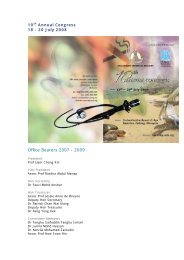download - Malaysian Thoracic Society
download - Malaysian Thoracic Society
download - Malaysian Thoracic Society
You also want an ePaper? Increase the reach of your titles
YUMPU automatically turns print PDFs into web optimized ePapers that Google loves.
Annual Congress of <strong>Malaysian</strong> <strong>Thoracic</strong> <strong>Society</strong><br />
OP 5<br />
DREV1 Silencing Promotes Cell Proliferation and<br />
Invasion in Lung Adenocarcinoma<br />
Nur Shukriyah Mohamad Hazir 1,4 , Pang Jyh Chyang 1 , Isa Rose 3 , Roslina Abdul Manap 2 ,<br />
Fauzi Anshar 2 , Nor Adina Ahmad Tajudin 2 , Andrea Ban Yu-Lin 2 , Roslan Harun 1,2<br />
1<br />
UKM Medical Molecular Biology Institute (UMBI), 2 Department of Medicine,<br />
3<br />
Department of Pathology, UKM Medical Centre, Universiti Kebangsaan Malaysia, Kuala Lumpur, Malaysia<br />
4<br />
Institute of Medical Science Technology (MESTECH), Universiti Kuala Lumpur, Malaysia<br />
Introduction<br />
We have previously identified that decreased expression of DREV1 was associated with shorter survival in<br />
patients with advanced non-small cell lung cancers (NSCLCs). The exact mechanism how reduction of DREV1<br />
leads to shorter survival is still not known.<br />
Objective<br />
To determine the roles of DREV1 in cancer progression Methods: Quantitative Real Time PCR (qPCR) and<br />
Tissue Microarray Immuno-histochemistry (TMA-IHC) were performed to validate the expression of DREV1.<br />
Silencing of DREV1 was done using DHARMACON SmartPooled Small Interfering RNA (Thermo Scientific)<br />
on the A549 lung adenocarcinoma cell line. Cell viability and apoptosis were measured using CellTiter-<br />
Glo® Luminescent Cell Viability Assay (PROMEGA) and Caspase-Glo® 3/7 Assay (PROMEGA) respectively.<br />
The effect of DREV1 inhibition on cell invasion was studied using QCMTM 24-well Collagen-Based Cell<br />
Invasion Assay–Colorimetric (CHEMICON). The downstream genes and signal cascades were interrogated<br />
using Illumina HumanRef-8 v3.0 Expression BeadChips.<br />
Results<br />
qRT-PCR confirmed that the expression of DREV1 was significantly higher in the long survival group (n=8)<br />
compared to the short survival group (n=8). TMA-IHC showed the DREV1 expression was reduced in<br />
advanced stages of NSCLC (Stage III and IV) compared to the early stages (Stage I and II). Silencing of DREV1<br />
increased cell proliferation, reduced apoptosis through reduction in Caspase 3 and 7 activities and increased<br />
cell invasion. Microarray gene expression analysis revealed that silencing of DREV1 activated SRC, GNAQ<br />
and PIK3R, mediators of PAR1 and PKY2/ERK/MAPK pathway that promotes proliferation, migration and cell<br />
invasion.<br />
Conclusions<br />
Reduced expression of DREV1 may contribute to poor survival in NSCLCs through increased cancer cell<br />
proliferation and cell invasion, and reduced apoptosis.<br />
52








